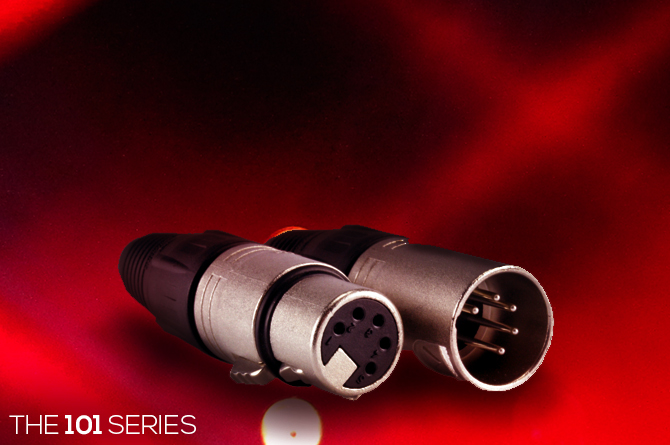

Whether you are at a concert, a church, a play, or a television studio, most likely you’ve seen some lighting that is controlled by DMX. No matter if you’re using a small 4 fader lighting board, or a full size lighting console, or whether you have 1 can light plugged into a dimmer pack, or you’re using a complex automated fixture, they are all going to be controlled by DMX. No matter how advanced your rig is, knowing how DMX works is going to help you with troubleshooting and set up.
A single run of DMX can support up to 512 channels. A channel is basically 1 basic function for a fixture, so for example, if you have a normal every day lamp and you plug it into a dimmer pack, this lamp can only fade up or fade down, so this lamp would have 1 channel. A moving light on the other hand might have many functions, such as: intensity, pan, tilt, zoom, color control, gobo control, prism control, etc. A Clay Paky Sharpy for example, uses 16-20 channels per fixture based on what mode it’s set on.
When setting up a lighting system with DMX, your lighting controller and all of your fixtures will be connected into one chain of cables. So you would start at your controller, connect a cable from the controller to light number one, from number one to number two, number two to number three, and so on. You can continue this chain up until you have a total of 512 channels. So if you wanted to hook up 10 Sharpys, and each one takes 20 channels, that would be 200 channels used up all together. 512 channels of DMX make up what is called 1 “Universe.” Depending on what type of controller you are using you may be able to connect it to more than 1 universe at a time.
To get your lights connected to DMX and working properly they need to be “patched” and “addressed”. An Address is a number given to a certain fixture that helps the board tell it what to do. What addresses you use is dependent on how many channels that fixture requires. For example, if you hooked up three Sharpys, and each needed 20 channels, you might set the first one at channel 1, since the sharpy takes up 20 channels, then that would mean it would be using channels 1-20, the second would then be set to channel 21, and would use channels 21-41, the third would be numbered 42, and would be using channels 42-62. Once they are addressed they would need to be “patched” which simply means telling your controller what address you have all of the lights set at.
How each fixture is controlled is different based on the make and model, but your manual should include a DMX chart for any sort of intelligent light that has more than one channel, it will tell you what each channel does and what value gives it a certain result. When you bring a fader up, you are basically giving that channel a value between 0 (Usually all the way down) and 255 (Usually all the way up.) For example, it might say that channel 1 is color control, values 1-25 will give you a green color, 26-50 will be red, and so on, so moving the fader up and down will trigger those different colors based on what value you have the fader set at.
A DMX error can cause all sorts of problems, if you start to find that some of your fixtures have stopped responding, or are acting strange, first check your addresses and make sure that nothing overlaps, then check your cables to make sure you don’t have a short. And remember, since DMX is connected as one long run, if you have a cable or fixture go bad, then not only will that fixture stop responding, but every fixture after it will stop to respond as well.
Hope that this information is helpful! I know that it’s very basic, but that’s the idea of the 101 series. If there’s anything you think I’ve missed, feel free to chime in!